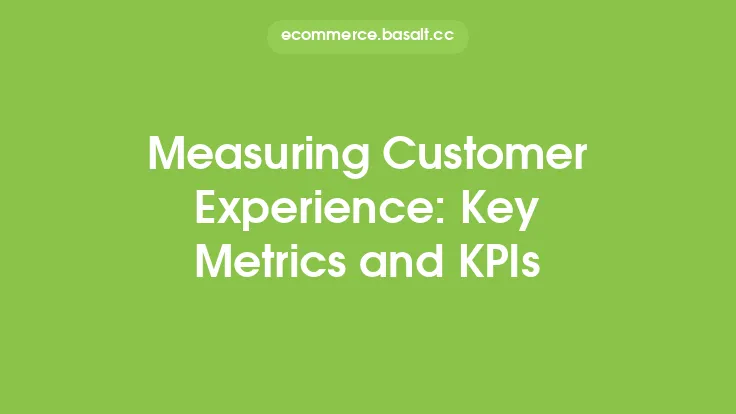Measuring customer satisfaction is a crucial aspect of e-commerce, as it helps businesses understand their customers' needs, preferences, and pain points. By tracking key metrics and benchmarks, e-commerce companies can identify areas for improvement, optimize their customer service strategies, and ultimately drive business growth. In this article, we will delve into the world of customer satisfaction measurement, exploring the most important metrics, benchmarks, and best practices for e-commerce businesses.
Introduction to Customer Satisfaction Metrics
Customer satisfaction metrics are quantifiable measures that help businesses evaluate the level of satisfaction their customers experience when interacting with their brand, products, or services. These metrics can be categorized into two main types: transactional and relational. Transactional metrics focus on specific interactions, such as purchases or support requests, while relational metrics assess the overall customer relationship. Common customer satisfaction metrics include Customer Satisfaction (CSAT), Net Promoter Score (NPS), Customer Effort Score (CES), and First Contact Resolution (FCR). Each of these metrics provides valuable insights into different aspects of the customer experience, enabling businesses to identify areas for improvement and optimize their customer service strategies.
Understanding Key Customer Satisfaction Metrics
To effectively measure customer satisfaction, e-commerce businesses need to understand the nuances of each key metric. CSAT, for example, measures how satisfied customers are with a specific transaction or interaction, typically on a scale of 1-5. NPS, on the other hand, gauges customer loyalty by asking one simple question: "On a scale of 0-10, how likely are you to recommend our brand to a friend or colleague?" CES evaluates the ease of interaction, asking customers to rate the effort required to resolve an issue or complete a task. FCR measures the percentage of customer issues resolved on the first contact, providing insight into the efficiency of support processes. By tracking these metrics, businesses can gain a deeper understanding of their customers' experiences and make data-driven decisions to improve satisfaction.
Benchmarking Customer Satisfaction
Benchmarking involves comparing an organization's customer satisfaction metrics to industry averages or best practices. This helps businesses understand their performance relative to competitors and identify areas for improvement. Industry benchmarks for customer satisfaction metrics vary, but general guidelines include: CSAT scores above 80%, NPS scores above 20, CES scores below 4, and FCR rates above 70%. E-commerce businesses can use these benchmarks to set realistic targets, prioritize improvements, and monitor progress over time. Additionally, benchmarking enables companies to stay competitive, as they can compare their performance to industry leaders and strive for excellence.
Collecting and Analyzing Customer Feedback
Collecting and analyzing customer feedback is essential for measuring customer satisfaction. E-commerce businesses can gather feedback through various channels, including surveys, reviews, social media, and support interactions. To ensure accurate and actionable insights, businesses should use a combination of quantitative and qualitative feedback methods. Quantitative methods, such as multiple-choice surveys, provide numerical data for benchmarking and trend analysis. Qualitative methods, such as open-ended surveys or social media listening, offer rich, contextual insights into customer experiences and pain points. By analyzing customer feedback, businesses can identify patterns, trends, and areas for improvement, ultimately informing data-driven decisions to enhance customer satisfaction.
Implementing a Customer Satisfaction Measurement Program
To establish an effective customer satisfaction measurement program, e-commerce businesses should follow a structured approach. First, define clear goals and objectives, such as improving CSAT or increasing customer loyalty. Next, select the most relevant metrics and benchmarks for the business, considering industry standards and best practices. Then, design a feedback collection strategy, choosing the most suitable channels and methods for gathering customer insights. After collecting and analyzing feedback, businesses should prioritize improvements, focusing on the most critical issues and opportunities. Finally, implement changes, monitor progress, and continuously refine the customer satisfaction measurement program to ensure ongoing improvement and growth.
Best Practices for Measuring Customer Satisfaction
To maximize the effectiveness of customer satisfaction measurement, e-commerce businesses should adhere to several best practices. First, ensure that feedback collection methods are convenient, easy to use, and non-intrusive, to encourage high response rates and accurate insights. Second, analyze feedback in a timely and actionable manner, using insights to inform improvements and optimize customer service strategies. Third, communicate changes and improvements to customers, demonstrating a commitment to their satisfaction and loyalty. Fourth, establish a culture of customer-centricity, empowering employees to prioritize customer satisfaction and driving business-wide engagement. By following these best practices, e-commerce businesses can create a robust customer satisfaction measurement program, driving growth, loyalty, and long-term success.
Overcoming Common Challenges in Measuring Customer Satisfaction
Measuring customer satisfaction can be challenging, especially for e-commerce businesses with limited resources or complex customer bases. Common challenges include low response rates, biased feedback, and difficulty in prioritizing improvements. To overcome these challenges, businesses can use incentives, such as discounts or rewards, to encourage feedback participation. They can also use advanced analytics and machine learning algorithms to identify patterns and trends in customer feedback, reducing bias and improving insight accuracy. Additionally, businesses can prioritize improvements based on customer effort, focusing on the most critical issues and opportunities that require the least effort to resolve. By addressing these challenges, e-commerce businesses can establish effective customer satisfaction measurement programs, driving business growth and customer loyalty.
The Future of Customer Satisfaction Measurement
The future of customer satisfaction measurement will be shaped by emerging technologies, changing customer expectations, and evolving business priorities. Artificial intelligence, machine learning, and natural language processing will play increasingly important roles in analyzing customer feedback, identifying patterns, and predicting satisfaction trends. Additionally, the rise of omnichannel commerce and social media will require businesses to adapt their customer satisfaction measurement strategies, incorporating new channels and feedback methods. As customer expectations continue to evolve, businesses will need to prioritize proactive support, personalization, and empathy, using customer satisfaction measurement to drive continuous improvement and innovation. By embracing these changes and advancements, e-commerce businesses can stay ahead of the curve, delivering exceptional customer experiences and driving long-term success.





